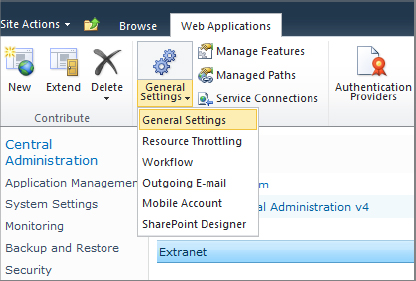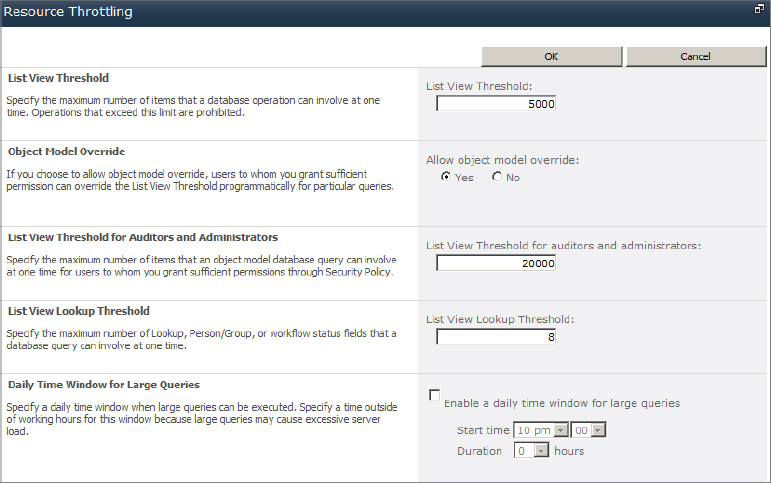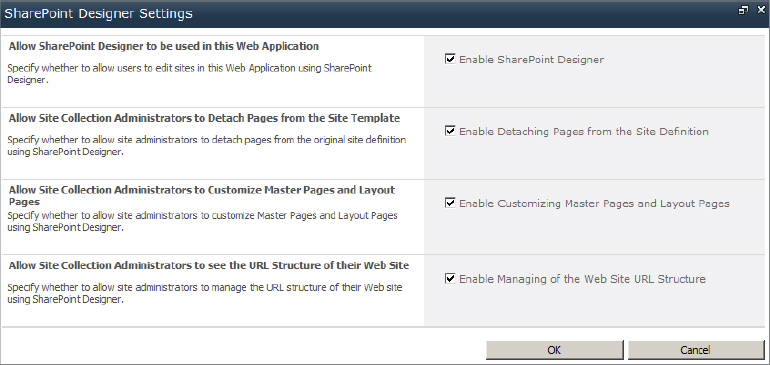Once you’ve created the web application and made the IIS adjustments, there are a few additional settings that you might want to change in order to fine-tune how your web application will function. This section covers the most commonly used settings found within Central Administration on the Web Applications Management page (click Application Management, then select Manage Web Applications).
Configuring General Settings
The General Settings section includes a wide range of settings, from maximum file size, to alerts thresholds, to how recycle bins are used. You can find these configuration options by clicking General Settings in the ribbon (see Figure 2.15).
Figure 2.15: Configuring General Settings

Some of the settings are described here:
Default Time Zone Each web application has a default time zone setting that determines what time zone the root website of each site collection created will use. If you do not specify one, the time zone of the WFE server is used. While you can change the time zone for websites by modifying Regional Settings, it’s easier to set the most common time zone to be the default here.
Default Quota Template A quota template is used to restrict the amount of space used in a site collection. A newly-created web application does not have a default quota template assigned. Unless you set a default quota template here, a newly created site collection is not assigned a quota, and the site collection can grow uncontrolled, causing space problems within its content database. We recommend setting a default quota template to ensure a quota is automatically applied to new site collections. Quota templates are covered in more detail in Chapter 3.
Browser File Handling The Browser File Handling setting tells SharePoint to add a special value in the HTTP header when downloading certain file types. The default setting is Strict, which prevents the browser from automatically opening these files. This setting is designed to eliminate a security risk that is posed if a file is corrupted or written to exploit a known security hole.
NOTE As of this writing, the Browser File Handling setting works only with Internet Explorer 8 and 9. Other browsers ignore this setting.
The Strict setting prevents PDF files from automatically opening up in the browser using the Adobe Reader plug-in. Instead, it forces users to save the file and open it on the computer. If security is the top priority in your environment, the best practice is to keep the setting as Strict. Otherwise, you might consider changing the value to Permissive.
Maximum Upload Size By default, SharePoint limits any single file (or group of files if using the multiple file upload) to 50 MB. This limit is controlled at the web application level. You can change the setting to allow files as large as 2 GB.
TIP Even if you increase the maximum upload size, you may still have issues uploading large files. The most common reason is because of a timeout. To resolve the problems, follow the steps in the article “Error Message When You Try to Upload a Large File to a Document Library on a Windows SharePoint Services 3.0 Site” at http://support.microsoft.com/kb/925083. This Knowledgebase article was written for SharePoint 2007, but it still applies to 2010 if you adjust the path from 12TEMPLATELAYOUTS to 14TEMPLATELAYOUTS.
TIP If you are running SharePoint on Windows Server 2008 (not 2008 R2), the maximum upload size is also restricted by the operating system and IIS 7.0. You will need to increase the maximum upload size in the web.config file. See the article “You Cannot Upload Files That Are Larger than 28 MB on a Windows Server 2008-Based Computer That Is Running Windows SharePoint Services 3.0” at http://support.microsoft.com/kb/944981 for more information on how to make this change.
Configuring Resource Throttling
One of the new features in SharePoint 2010 is a restriction on the number of list or library items that can be returned in a single request. This is called large list throttling and it helps prevent expensive queries from causing major performance problems. By default, SharePoint limits any request to 5,000 items, as shown in Figure 2.16. Requests that exceed this limit are not executed and an error message is returned.
Figure 2.16: Configuring Resource Throttling settings

Users who are administrators or auditors (as defined by the web application policy) can request up to 20,000 items, assuming Object Model Override is enabled and custom code is used.
Custom processing jobs that run during night hours or other slow periods may run special queries that exceed the resource throttling thresholds. Fortunately, there is a setting shown at the bottom of Figure 2.16, Daily Time Window For Large Queries, that addresses this need. By enabling the daily time window, you can turn off throttling for one or more hours.
TIP As a general rule, it is a best practice to ensure that lists and libraries do not grow so large that this throttling is applied. You can do so by ensuring that list and library views have an item limit set to display only a small subset of items per page (by default, the item limit is set to 30 and can be adjusted when you are configuring the view). Folders can also be used to help manage size limits since most queries only return items from a single folder. For more details, please refer to the white paper titled “Designing Large Lists Maximizing Lists Performance” downloadable from www.microsoft.com/downloads/en/details.aspx?FamilyID=fd1eac86-ad47-4865-9378-80040d08ac55.
Disabling SharePoint Designer
SharePoint Designer is a powerful application that provides useful features to administrators, site owners, and designers. However, this power comes at the risk of potentially breaking websites. As a farm administrator, you have the option of disabling certain aspects of SharePoint Designer for web applications. As shown in Figure 2.17, there are four ways of controlling how SharePoint Designer can be used within a web application.
Figure 2.17: Disable SharePoint Designer

These four settings can also be controlled by site collection administrators at the site collection level; however, any setting turned off for the web application takes precedent over the site collection setting. For more information on each of these settings, see the article “Managing SharePoint Designer 2010” at http://office.microsoft.com/en-us/sharepoint-designer-help/managing-sharepoint-designer-2010-HA101838275.aspx.
Configuring Blocked File Types
The Blocked File Types setting defines what file extensions are allowed to be uploaded as list attachments or library items. By default, file extensions that introduce a security risk are prohibited. As part of a governance strategy, you may need to add or remove entries. For example, if MP3 files should be disallowed, simply add the .mp3 extension to the list of entries.
